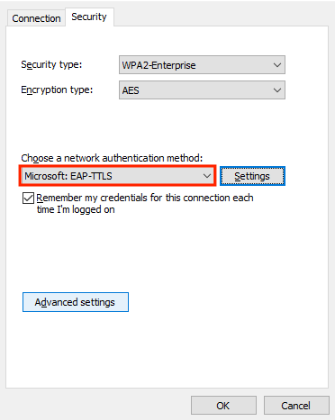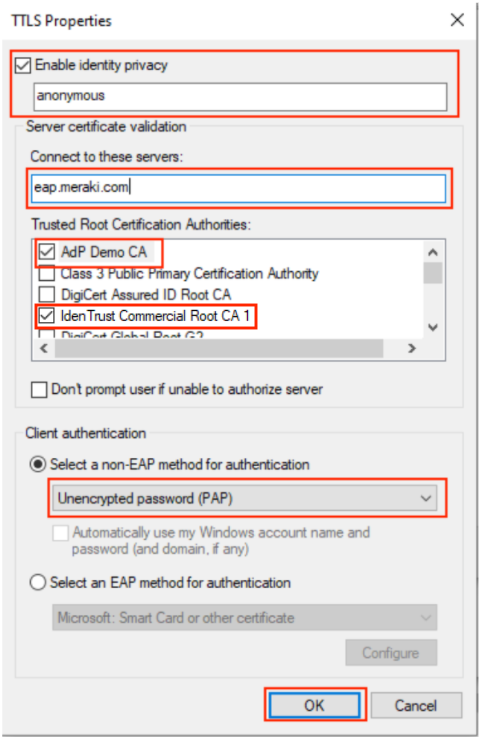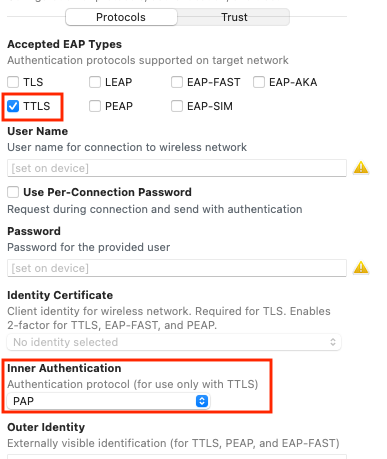EAP-TTLS/PAP Username+Password Authentication with Entra ID Lookup
This article explains how to configure username and password based authentication against Microsoft Entra ID to apply an identity-based dynamic authorization to the users and endpoints connecting to your network.
Although certificate-based authentication is the most secure method, some organizations may not have their own public key infrastructure (PKI) and/or need an alternative method such as username and password authentication. With Username/Password-based authentication (EAP-TTLS/PAP) against Entra ID, you can control network access to your Managed endpoints without the need for deploying and maintaining external PKI infrastructure.
Authentication Flow
First, let’s try to understand the authentication flow for this specific use case. As shown in the diagram below, our goal is to enable end-users or endpoints connect to the network (SSID or a switch port) using their domain username and password.
The authentication flow is:
- The endpoint initiates the connection with the SSID or switch port.
- The network device will request the identity of the endpoint.
- The user will enter their username and password or the endpoint uses the saved credentials that will be sent to network device.
- The network device will forward the identity information within a RADIUS packet to Cisco Meraki Cloud over a Cisco proprietary AES-256-bit encrypted TLS tunnel.
- Cisco Meraki Cloud will authenticate the user directly against Entra ID.
- Cisco Meraki Cloud would have already synchronized users, user groups and user attributes from Entra ID Graph API integration and stored them in its local database.
- Access Manager evaluates the session against the configured rules – a rule is matched if all the defined conditions (like user identity from Entra ID, endpoint identity, network information and others) are matched and the corresponding configured authorization will be applied as a result.
- The resulting authorization (for example SGT, VLAN and others) will be sent back to the network device for enforcement.
- The endpoint will be connected successfully.

Configuration Steps
This section covers the configuration steps at a high-level to explain various components of the workflow. The configuration needed for this use case can be broken down into following steps:
- Configure endpoints for username and password authentication
- Configure Entra ID integration to synchronize users, user groups and user attributes
- Configure SSIDs and Switches to use Access Manager
- Configure authorizations to be used – SGTs, VLANs, Group Policies and others
- Configure Access Manager rules for policy evaluation
Configure Endpoints For Username/Password Authentication
Refer to the following article to view OS level instructions in configuring your endpoints for Username and Password authentication against Access Manager: Access Manager - EAP-TTLS Client Configuration (Windows, macOS and iOS)
Configure Entra ID Integration
Configure Entra ID integration to synchronize all the users, user groups and attributes and store them in Cisco Meraki Cloud database. A proactive synchronization occurs every six hours, and you can initiate a manual synchronization at any time.
Refer to our documentation Organization End Users for more detailed instructions.
Entra ID integration synchronizes users, user groups, and user attributes. However, since password synchronization is not allowed, the integration is also used to perform real-time username and password authentication against Entra ID for Username/Password authentication flows. After successful authentication, Access Manager performs a user lookup against the synchronized Entra ID database. The session is then evaluated against the configured access rules to determine authorization (e.g., SGT, VLAN) based on user groups like HR and Finance or other attributes from Entra ID.
|
Important: Make sure to set these API permissions at minimum and grant admin consent :
|
 |
Configure Wireless And Wired Networks To Use Access Manager
Configure Wireless SSID Access Control Settings
|
 |
|
 |
Extended Local Auth is only applicable for certificate (EAP-TLS) based authentication. Selecting this will ensure that this certificate chain is downloaded on all the MRs that are configured with an SSID that uses Access Manager. In the event of Cisco Meraki Cloud not being reachable, any new endpoints trying to authenticate will be authenticated by the local RADIUS server on each MR using the certificate it downloaded previously. Note that the rules evaluation will not work but instead, the VLAN configured on the SSID will be applied to the session after successful authentication. Make sure to enable this on both the certificate and the SSID Access Control Page.
- Changes to any other SSID settings like Client IP and VLAN assignment, etc. can be made as needed and
- Select Save at the bottom.
Wired - Configure Access Policy and Switch Port
For Wired connections, you will need to configure an Access Policy that uses Access Manager as the authentication method and attach that Access Policy to the switch port where the endpoint/s will be connecting.
These are the steps at a high-level to configure access policy and switch ports to use Access Manager as the authentication server:
For detailed instruction on how to configure Access Policies, refer to our documentation on Access Policy.
|
 |
|
 |
Configure Access Manager Rules
Now that we have everything in place, it is time to configure the Access Manager rules which will determine what authorization (SGTs, VLANs, Group Policies) will be applied to the endpoints when they authenticate.
The rule framework is very straightforward – define the matching criteria and define the corresponding authorization result to be assigned. Following are the steps needed for this configuration:
Access rules are evaluated sequentially from top to bottom. A session will match a rule ONLY IF ALL the conditions specified in the "What's Matched" section are satisfied. This means the conditions are linked by an "AND" operator, requiring each condition to be met for a successful match. If a rule is not matched, the evaluation process continues to the next rule in the list until the default rule is reached.
| Here is an example rule that we will use to illustrate on how to configure rules |
 |
|
Navigate to Access Manager > Policies > Access Rules. For this Early Access Preview, we only support one rule group (default rule group) with the ability to add multiple rules under it. |
|
|
To add a rule, select Add a rule. Name and enable the rule.
|
 |
|
Under Authorization section, select Access permission dropdown to choose an option.
Refer to our Adaptive Policy documentation on how to implement zero-trust micro-segmentation policies through Adaptive Policy.
Refer to our Group policy documentation on how define and apply a list of rules, restrictions, and other settings to the endpoints that are connecting to your network.
|
 |
|
Now, any endpoint matching the criteria defined in the rule (Entra ID Group = Product Management) will be matched with the rule and corresponding authorization (VLAN = 250 and Adaptive Policy = FTE-Laptops) will be applied. |
Troubleshooting
If there are any issues in signing in users, make sure to confirm the following:

Windows
|
Open the supplicant connection properties
|
 |
|
Enable identity privacy
|
 |
Apple macOS (using apple configurator)
|
 |
Additional Steps
- Verify username and password: Verify that the correct username and password are entered while authenticating.
- Verify password used is not a temporary password: Temporary passwords for the users are not supported on this flow. To change the temporary password for a user, login to any Microsoft portal (eg: portal.azure.com) to manually set the password.
Verify access rule configuration: Verify that the access rules configured (Access Manager > Policies > Access Rules) are correct and include matching criteria for the authentication. Following is an example access rule: -
Verify wired/wireless supplicant configuration: Verify that the wired/wireless supplicant configured on the endpoint includes EAP-TTLS as the authentication method and PAP as the inner method (macOS) / non-EAP method (windows) at minimum.
- For detailed instructions, Refer to Access Manager - EAP-TTLS Client Configuration (Windows, macOS and iOS)
- Verify API permissions on Entra ID: Verify that the following API permissions are added on Entra ID app registration that was configured for the integration:
- Graph API> Application > Directory.Read.All
- Graph API > Application > User.Read.All
- Graph API > Delegated > User.Read
Note: Select "Grant admin consent for Default Directory" after adding the the above permissions. Make sure the status shows "Granted.."

- Verify security settings on Entra ID: EAP-TTLS/PAP does not support MFA authentication. It is important to exclude the "app registration" created during Entra ID integration step discussed above from MFA authentication using Conditional Access Policies. Conditional Access Policies requires a paid subscription for Entra ID. Following are overview steps:
Warning: Proceed with caution as these changes may severely impact your security settings. Following steps are for information purposes only. Many organizations may have different settings that may require changes accordingly.
Refer to following resources for more details on security defaults and conditional access:
Security defaults in Microsoft Entra ID
Conditional Access in Microsoft Entra ID
- Disable security defaults:
|
 |
Configure conditional access policies:
|
|
 |

